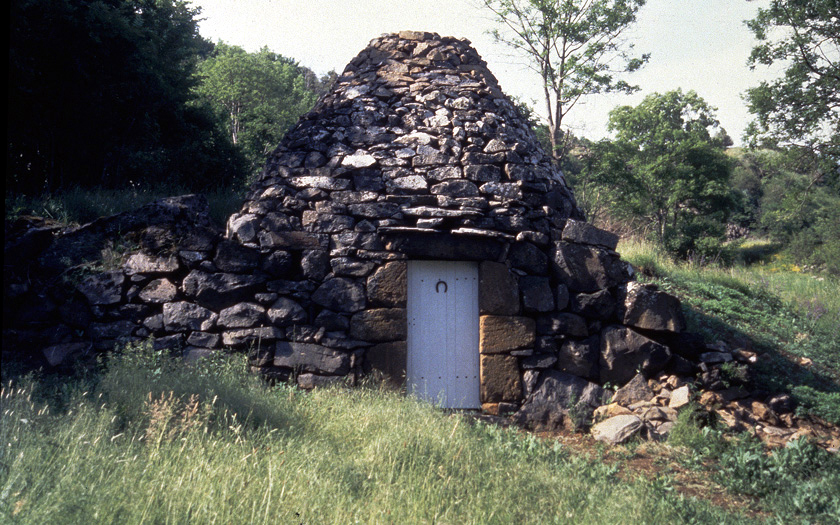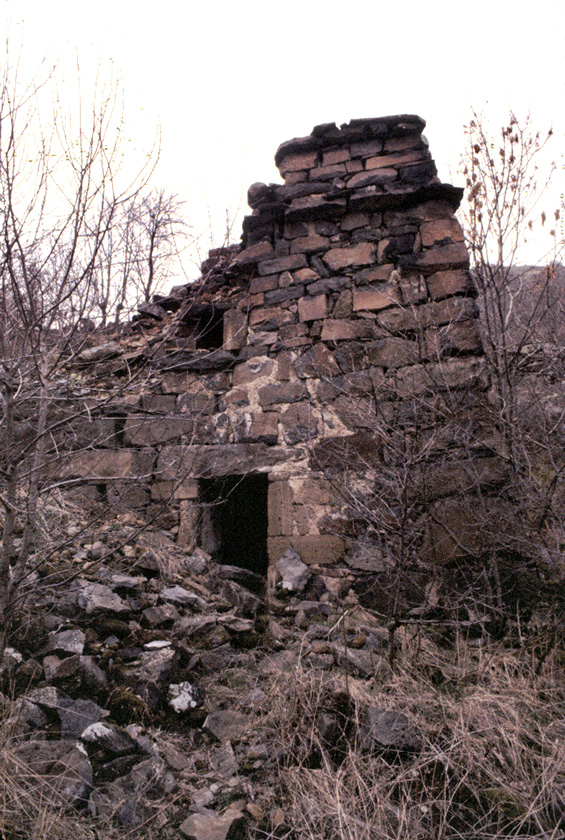|
THE "CHIBOTTES" HIKING TRAIL AT
VALS-PRÈS-LE-PUY, HAUTE-LOIRE: Christian Lassure The “Chibottes' Trail” is a short hiking trail (PR 638) located in the "commune" of Vals-près-le-Puy in Haute-Loire. It runs its route in the Dolaison vale to the west of the town and connects old dry stone vineyard huts, built in the 19th century for the Ponots (the inhabitants of Puy-en-Velay) and locally called “tsabones” (i.e. "cabanes" in French) during the vineyard era then renamed “chibottes” in the 20th century following the local scholar Albert Boudon-Lashermes, who saw them as the work of the Ligurians. A long-term project If the project of restoration and tourist development of these basalt huts dates back to the 1970s, it had to wait until the first decade of the 21st century to take shape. In 2009, the municipality of Vals acquired the right of pre-emption on the plots of a deferred development zone which had just been created, under the name "ZAD des chibottes", in the Dolaison vale (places known as Lous Cros, La Plone, Les Péreyres, Laval, Louis Crouzace, Lamare, Bois de Lirate, Crostet, Les Closses, Pré Devèze, Pralong). This ZAD was to allow the municipality to acquire plots where huts are located in order to be able to bring its project to fruition. In 2010, the inhabitants of Vals learned that a 6 km hiking trail wouldl be created from the town hall. It would require various development works, including the rehabilitation of two chibottes for an estimated cost of 75,000 euros excluding tax. Funding would be provided by the Puy-en-Velay urban community. On November 5, 2011, the inauguration of the “chibottes route” took place, made possible by the acquisition of five huts by the municipality and their restoration at the cost of 100,000 euros advanced by the agglomeration, the department, the State and Europe.
From March 11 to April 11, 2013, a public inquiry was held concerning the “listing of the site of the Dolaison gorges and the Chibottes vale”, straddling the municipalities of Vals-près-le-Puy and Saint-Christophe-sur-Dolaison. The Dolaison vale, upstream of Vals, was proposed to join the list of sites listed and protected as natural monuments and sites of artistic, historical, scientific, legendary or picturesque character (law of 1930). As of March 8, 2016, the Dolaison gorges and the “Chibottes vale” became a listed site as a landscape. In 2022, an inventory of dry stone walls was undertaken in the deepest part of the gorges, where the lithic remains of the old 19th century vineyard are still found. The operation was entrusted to a mapping service and a local “waller” (dry stone mason) (cost: 14,000 euros). In 2023, restoration work began on the site of the large hut called “the Chieftain's Hut” or “the Town Hall” by the Valadiers, with a view to its inclusion in the tourist circuit. The top of its flat facade had collapsed and its cone roof was truncated. The funding of the work amounted to 45,400 euros, of which 40% came from the Puy-en-Velay urban community (18,160 euros), 30% from the Department (13,620 euros) and 30% from the Region (13, 620 euros). The restoration, entrusted to the wall builders of the “Pierre Sèche” association of Haute-Loire, was completed at the beginning of 2024. An outstanding natural setting At the gates of the Puy-en-Velay agglomeration, in the communes of Vals-près-le-Puy and Saint Christophe-sur-Dolaison, the Dolaison gorges, which cut into the large basalt lava flows coming from the Devès plateau, are recognized as an outstanding space for its landscape, flora, fauna, hydrology, geology and architectural heritage. Entirely spared from urbanisation and easily accessible from Le Puy-en-Velay and the centre of Vals, the vale plays the role of a “proximity natural space” for the agglomeration. The most surprising spectacle is the cliff of the vale, a geological formation facing south, at least 1.5 km long, partly overlooked by the path to Santiago de Compostela. The lithic vestiges of the ancient vineyard The terrace walls and stone huts still visible on the slopes of the vale looking south bear witness to the wine-growing destination of the place in the 19th century, favored by a sheltered location, a south-facing exposure, rich volcanic soil and the use of late grape varieties to avoid spring frost. The configuration of the place, with its dark basalt walls, made it possible to store heat during the day and recirculate it during the night, at an altitude of around 750 metres. Struck by phylloxera, this wine-growing region was abandoned at the beginning of the 20th century. A double trail The trail exists in two variations: - the “Chibottes' Trail” itself, a large loop of 5.7 km and a 60 m difference in altitude starting from the town hall of Vals, at the entrance to the Saint-Dominique foyer, and partly taking the Chemin de Saint-Jacques -de-Compostelle (GR 65) on the return, - and the “tour des chibottes”, a small circuit of 1.7 km and 200 m difference in altitude, accessible from the road to Saint-Christophe-sur-Dolaison and a newly-created esplanade. Thirteen huts, eight private and five communal, are scattered along the small circuit, under various names, notably * the little Valadière Hut ; * the Perbet Hut ; * Odile's Hut ; * the Grand Duke's Hut; * the Lirate Woods Hut (in the cadastral plot AA 77), property of the municipality, registered as a historic monument on April 28, 1986 (not to be confused with another hut located in the same place, but in the cadastral plot AA74, and belonging to an individual);
* the Vigneaux Hut, embedded, on the upstream side, in the bank and supported, on the downstream side, by a buttress (today the hut of the Vignerons de Vals society, which still maintains a few vines in the vale).
To this list was added the "Chieftain's Hut", also known as the "Town Hall", property of the commune, at a place called Le Crousas (an exceptional building with its vast dimensions, upper floor and high flat facade).
Besides getting a glimpse of ancient wine terraces, supported by a dry stone wall and called “chambées” in the region, hikers can cross, with good shoes, the chaotic scree of ancient basalt lava flows called “chiers.”
Installing a walkway The circuit was extended in 2023 by a section of almost a kilometer, on which a suspended walkway from tree to tree was installed, made up of wooden decking and steel cabling and 28 m long by 70 cm wide. Capable of supporting five people at a time, it allows hikers to cross the Dolaison to the west of the circuit (total cost of the operation: 42,000 euros including tax). Restorations Several huts in poor condition have been restored or even rebuilt by a local company specialising in dry masonry.
Reconstructing the true history of the site and its remains The Chibottes' Trail is the subject of a descriptive page on the Vals website. Amidst factual information, some erroneous or unfounded assertions stand out.
The chibotte is “covered by a false corbelled dome, the origin of which is controversial”: first of all, the “false dome” is, in scholarly architecture, a wooden covering which is placed under a frame and painted so as to imitate a cut stone vault ; secondly, the question of the origins of the corbelled vault only makes sense for the tombs of Prehistory or Antiquity.
“Some people attribute the construction of Chibottes near the Troglodytes caves to the Ligurians”: “some people” stands for a local scholarly glory from the first half of the 20th century, Albert Boudon-Lashermes, who saw the hand of the Ligurians, living 3,000 years ago, in the construction of the huts; no historian today supports this theory, already rejected in his time.
“Others think that these are constructions erected by winegrowers, shepherds or farmers”: in the case of Haute-Loire, if the construction of stone huts by winegrowers is well documented, on the other hand it is excluded for shepherds, who have nothing to do in protected plots of vines. In fact, the shepherd in charge of a flock was housed by his employer in a wooden caravan, easier to move than a hut weighing 50 to 250 tonnes of stone depending on its size.
To drive the point home about the Ligurian chibottes, the visitor is treated to a quote from Boudon-Lashermes: “These small dry stone huts, with their pointed roofs, have defied centuries. They are still standing, as sturdy after 3,000 years of existence as the rocks that overlook them.”
Sources Classement du site des gorges du Dolaison, décret du 8 mars 2016. Nouvelles du monde de la pierre sèche, sur pierreseche.com : Cyrille Marlin, Victor Miramand et Marie Baret, Réflexion sur la mise en cohérence des périmètres de protection sur le bassin du Puy-en-Velay, DREAL, décembre 2011, 188 pages, pp. 99-101 - site : Les gorges et falaises du Dolaizon, Vallée du Dolaizon, Croustet, Mont Ronzon - Communes : Vals-près-le Puy, Ceyssac, Espaly, Saint Christophe-sur-Dolaizon). Les chibottes se dévoilent à Vals-près-le-Puy, L'Éveil de la Haute-Loire, 15 août 2021. Chibotte du bois de Lirate, inscrite au titre des monuments historiques le 28 avril 1986, notice No PA00092909 sur la Base Mérimée du ministère français de la Culture. Une passerelle suspendue sur le sentier des chibottes, sur agglo-lepuyenvelay.fr, 27 mai 2023.
Hyperlinks on this site or on pierreseche.com Ciabot ou bori ? (reprise, augmentée, d'un article paru dans le tome 22, 1998, de la revue L'Architecture vernaculaire, sous le titre Ciabots, pierriers et murs en pierre sèche des Alpes-Maritimes)
La « chibotte du chef » ou « mairie » à Vals-près-le-Puy (Haute-Loire) http://www.pierreseche.com/la_chibotte_du_chef.htm 18 novembre 2002
La cabane du chemin de Bonnassou sur la commune de Vals-près-le-Puy (Haute-Loire) http://www.pierreseche.com/cabane_bonassou.htm 2 août 2003
Cabane de vigne au lieu-dit Chanceaux à Polignac (Haute-Loire) http://www.pierreseche.com/cabane_chanceaux.htm 15 août 2003
Cabane du vallon du Dolaison à Vals-près-le-Puy (Haute-Loire)
Les cabanes en pierre sèche du vignoble du Puy-en-Velay (Haute-Loire) : mythes et réalités (reprise, augmentée, de Les cabanes en pierre sèche de l'ancien vignoble du Puy-en-Velay (Haute-Loire) : mythes et légendes, dans La lettre du CERAV, No 12, septembre 2000, pp. 67-76) http://www.pierreseche.com/mythe_chibottes.html 22 octobre 2006
Les cabanes en pierres sèches de Vals-près-le-Puy (Haute-Loire) et alentour, Études et recherches d'architecture vernaculaire, No 27, 2007, 38 p., pp. 18-19
Grangette-étable à la façade plane et à l’arrière semi-elliptique à Vals-près-le-Puy (Haute-Loire) http://pierreseche.chez-alice.fr/vals_grangette-étable.htm 18 juin 2008 (aussi http://www.pierreseche.com/vals_grangette-etable.htm 18 juin 2008)
Série : La roulotte de berger, V - Berger et sa cabane à roues à Saugues (Haute-Loire) dans les années 1950
Dernières nouvelles des vestiges lithiques viticoles de Vals-près-le-Puy (Haute-Loire)
Remontage de la partie éboulée de la façade de la très grande cabane viticole dite « la cabane du chef » ou « la mairie », à Vals-près-Le Puy (Haute-Loire)
© Christian Lassure April 19th, 2024
To be referenced as: Christian Lassure The "Chibottes" hiking trail at Vals-près-le-Puy, Haute-Loire: architectural and historical relevance April 19th, 2024
|











